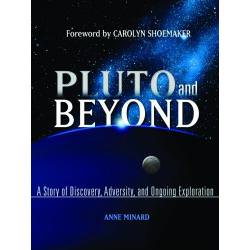Great riches can buy you a yacht, a mansion or even an observatory. Percival Lowell went for the later and thus, still today, there is the privately owned Lowell Observatory. This facility forms the basis for the topics in Anne Minard’s book, Pluto and Beyond – A Story of Discovery, Adversity, and Ongoing Exploration. Many stories within cover interesting personalities, advances in astronomy and thoughts on the future.
The Lowell Observatory in Flagstaff, Arizona is home to several, somewhat dated, telescopes and the under construction Discovery Channel telescope. The clear, dry skies and high elevation have drawn many amateur and professional night owls to learn more about the stars and other universe travelers. Their dedication and drive delivered us much important knowledge and continue to do so today.
Minard’s book is a dedication to the Lowell Observatory and many of the people who graced its buildings. But she doesn’t focus upon Percival Lowell, the founder, she looks at the lesser stars. For example, she has a good portion on Vesto Slipher and a bit on his brother Earl. She also powers up some lesser lights such as Art Adel, Henry Giclas and Robert Burnham. Some of her information comes from personal interviews where anecdotes and memories drift up from the pages. Others are from the Lowell archives and preserved astronomical tomes. With these solid references, the book’s contents ring true.
In addition to people, Minard uses her book to champion the work of astronomers, whether based at the Lowell Observatory or elsewhere. Sometimes there’s detail in depth, such as the workings of the Hubble space telescope, filar micrometres and blink plates. And there’s the results of the work with the instruments, including the Catalogue of Proper Motion Stars, Star Catalogues and asteroid searches. For example, there’s a brief bit on SQ222 and its chances of hitting Earth. Most of the work and results have some link to the Lowell Observatory, though it does get a bit tenuous.
This may seem like a lot of detail for one book, and it is. With all that the book covers, the book’s title is out of place. The book has very little mention of Pluto, except for being the push that catapulted the observatory on to fame. Equally, the concept of beyond is unclear. Rather, the book goes down memory lane to reprise the accomplishments that might be linked to the Lowell Observatory, as if trying to justify the observatory’s continued existence. However, the subtitle is more apt, as the book does concern itself with discovery, adversity and ongoing exploration.
This apparent mismatch in titles is symptomatic of the book’s weakness. As the title is unfocused and non illustrative of the contents, so too are the contents unfocused and thus don’t illustrate a particular theme. The book’s sections have the flavour of popular magazine articles that are pleasant to read but only loosely related and seldom directed. However, this doesn’t mean the prose is poor. Rather, like a magazine, the book’s sections are well written, informative and have some relevance to astronomy and the Lowell Observatory.
Therefore, the person most appreciative of this book is someone who likes articles written in the style of a magazine. Of course, they should be interested in astronomy and have a slight interest in the on goings at the Lowell Observatory. For example, the book would be a great reference for anyone contemplating a visit to Flagstaff.
Whether at your own backyard telescope, using an online telescope at a remote location or visiting a site miles away, it’s always nice to have clear skies and aided vision with which to see stars. Anne Minard in her book, Pluto and Beyond – A Story of Discovery, Adversity, and Ongoing Exploration writes of how the Lowell Observatory achieved such high regard in its services to astronomy, both for yesterday and with its plans for tomorrow.
Read more reviews online, or purchase a copy from Amazon.com
Here are some facts about Pluto, and some images of Pluto.

